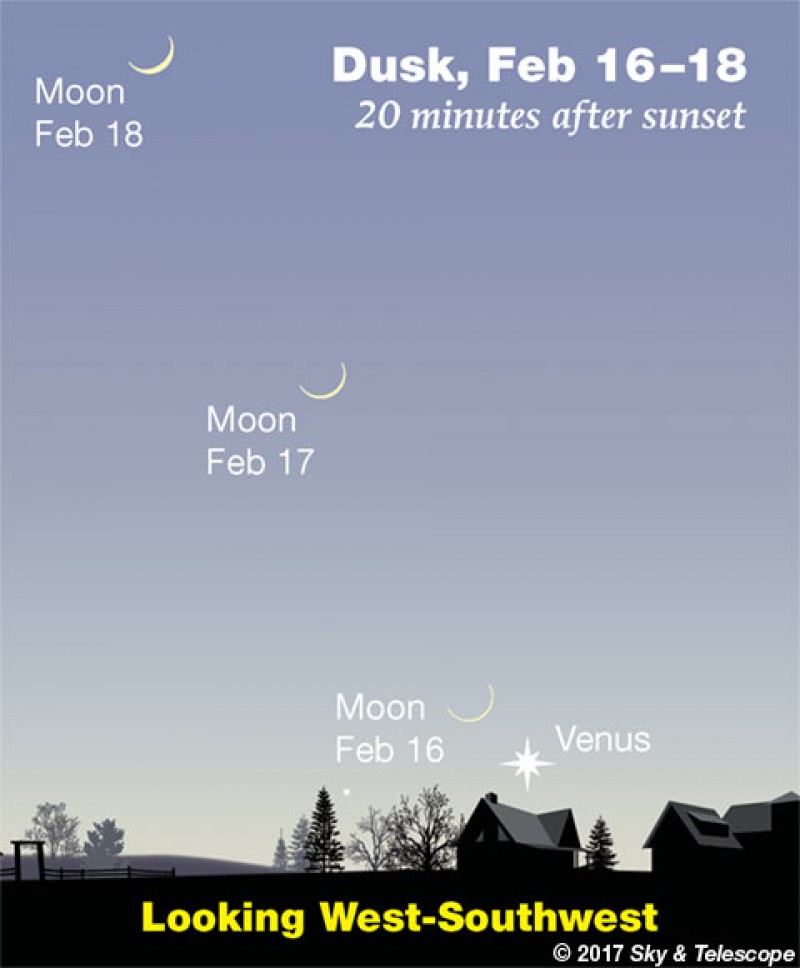
Friday, February 16
• About 15 to 20 minutes after sunset, use binoculars to look just above the west-southwest horizon for Venus and a super-thin crescent Moon, as shown at right. The crescent is only a little more than 24 hours old for North America; new Moon was yesterday at 4:04 p.m. EST.
Saturday, February 17
• Now the waxing crescent Moon is easier to see in the west-southwest after sunset. Its curved side points the way down toward Venus this evening and tomorrow, as shown at right.
Sunday, February 18
• During February, Orion stands high in the south after dinnertime. Lower left of it blazes Sirius, and farther left of Orion shines Procyon. Extending up from Procyon is dim little Canis Minor: the doglet whose top is barely visible in profile in a dark sky. He's currently vertical; Procyon is his rump. We only see stars marking the profile outline of his back (from Procyon up to 3rd-magnitude Gomeisa) and the back of his head (Gamma and Epsilon Canis Minoris just above Gomeisa, faint at 4th and 5th magnitude).
Monday, February 19
• If the Big Dipper stands upright in the northeast, can Bootes be far behind? The Dipper's handle famously arcs down and around toward Arcturus, the lucida (brightest star) of Bootes — and the arc crosses Bootes for most of the way. The whole constellation is above the east-northeast horizon by about 10 p.m. now. Spring approaches.
Tuesday, February 20
• After it's fully dark, look 15° (about a fist and a half at arm's length) upper right of the Moon for Hamal, the brightest star of Aries. The next two brightest stars of Aries, Sheratan and Mesarthim, hang below Hamal.
Continue the line from the Moon through Hamal onward by another fist (if you're observing from North America), and you're in dim Triangulum: long, thin, and pointing down.

The five brightest stars of Canis Major form a celestial meat cleaver. Due south of brilliant Sirius is the hazy star cluster M41.
Wednesday, February 21
• Sirius blazes high in the south on the meridian by 8 or 9 p.m. now. Using binoculars, examine the spot 4° south of Sirius: directly below it when on the meridian. Four degrees is somewhat less than the width of a typical binocular's field of view. Can you see an irregular little patch of gray haze? That's the open star cluster M41, about 2,200 light-years away. Sirius, by comparison, is only 8.6 light-years away.
Thursday, February 22
• The Moon this evening shines with Aldebaran and the Pleiades, as shown in twilight to the lower right.
• Under the feet of Orion, and to the right of Sirius now, hides Lepus the Hare. As with Canis Major, you can connect Lepus's dots to make it look like what it's supposed to be. He's a crouching bunny, with his nose pointing lower right, his faint ears extending up toward Rigel, and his body bunched to the left. His brightest two stars, 3rd-magnitude Beta and Alpha Leporis, form the front and back of his neck.
Friday, February 23
• First-quarter Moon (exact at 3:09 a.m. on this date EST). For North America this evening the Moon shines left or upper left of Aldebaran, and farther upper right of Orion, as shown here.
The Moon occults Aldebaran in daylight or twilight for northern and western Europe, and in darkness for much of Russia; map and timetables.
Saturday, February 24
• The Moon shines over Orion after dark, as shown here.
• Algol should be at minimum brightness, magnitude 3.4 instead of its usual 2.1, for a couple hours centered on 10:05 p.m. EST (7:05 p.m. PST).
This Week's Planet Roundup

"The Great Red Spot's colour is very striking at the moment — perhaps as colourful as I've ever seen it," writes planetary photographer Damian Peach. He took these images just 14 minutes apart (see how fast Jupiter rotates!) remotely from the UK using the 1-meter (40-inch) Chilescope with the aid of the Chilescope Team. South is up.
Mercury is hidden deep in the glow of sunset.
Venus is just beginning to emerge into view low in the afterglow of sunset. If the air is good and clear, look for it just above your west-southwest horizon 15 or 20 minutes after your local sunset time. Binoculars help. Venus is beginning an "Evening Star" apparition that will continue through next summer.
Mars and Jupiter (magnitudes +0.9 and –2.1, respectively) rise in the east-southeast around 12:30 and 2:30 a.m., respectively, depending on your location. By early dawn they're high in the south. Jupiter is the brightest point in the pre-dawn sky, shining in dim Libra. Mars glows about 20° to Jupiter's lower left, in the feet of Ophiuchus. Mars is upper left of very similar-looking Antares.
Saturn (magnitude +0.5, in Sagittarius) glows with a steady light low in the southeast in early dawn. Draw a line from Jupiter through Mars, extend the line farther on by about the same distance, and you're at Saturn.
Uranus (magnitude 5.9, in Pisces) is still fairly high in the west right after dark. Finder chart.
Neptune is lost in the sunset.
Source: Alan MacRobert
